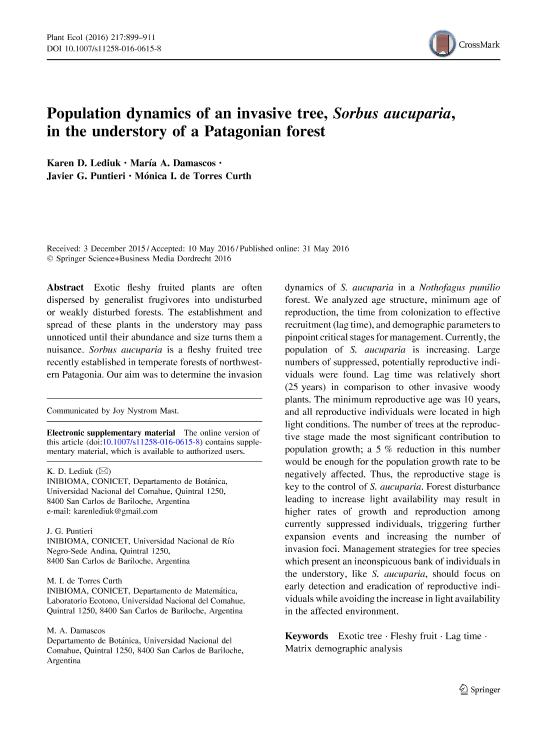Mostrar el registro sencillo del ítem
dc.contributor.author
Lediuk, Karen Daniela

dc.contributor.author
Damascos, Maria Angélica

dc.contributor.author
Puntieri, Javier Guido

dc.contributor.author
de Torres Curth, Monica Irma

dc.date.available
2018-06-26T15:15:51Z
dc.date.issued
2016-07
dc.identifier.citation
Lediuk, Karen Daniela; Damascos, Maria Angélica; Puntieri, Javier Guido; de Torres Curth, Monica Irma; Population dynamics of an invasive tree, Sorbus aucuparia, in the understory of a Patagonian forest; Springer; Plant Ecology; 217; 7; 7-2016; 899-911
dc.identifier.issn
1385-0237
dc.identifier.uri
http://hdl.handle.net/11336/50060
dc.description.abstract
Exotic fleshy fruited plants are often dispersed by generalist frugivores into undisturbed or weakly disturbed forests. The establishment and spread of these plants in the understory may pass unnoticed until their abundance and size turns them a nuisance. Sorbus aucuparia is a fleshy fruited tree recently established in temperate forests of northwestern Patagonia. Our aim was to determine the invasion dynamics of S. aucuparia in a Nothofagus pumilio forest. We analyzed age structure, minimum age of reproduction, the time from colonization to effective recruitment (lag time), and demographic parameters to pinpoint critical stages for management. Currently, the population of S. aucuparia is increasing. Large numbers of suppressed, potentially reproductive individuals were found. Lag time was relatively short (25 years) in comparison to other invasive woody plants. The minimum reproductive age was 10 years, and all reproductive individuals were located in high light conditions. The number of trees at the reproductive stage made the most significant contribution to population growth; a 5 % reduction in this number would be enough for the population growth rate to be negatively affected. Thus, the reproductive stage is key to the control of S. aucuparia. Forest disturbance leading to increase light availability may result in higher rates of growth and reproduction among currently suppressed individuals, triggering further expansion events and increasing the number of invasion foci. Management strategies for tree species which present an inconspicuous bank of individuals in the understory, like S. aucuparia, should focus on early detection and eradication of reproductive individuals while avoiding the increase in light availability in the affected environment.
dc.format
application/pdf
dc.language.iso
eng
dc.publisher
Springer

dc.rights
info:eu-repo/semantics/openAccess
dc.rights.uri
https://creativecommons.org/licenses/by-nc-sa/2.5/ar/
dc.subject
Exotic Tree
dc.subject
Fleshy Fruit
dc.subject
Lag Time
dc.subject
Matrix Demographic Analysis
dc.subject.classification
Otras Ciencias Biológicas

dc.subject.classification
Ciencias Biológicas

dc.subject.classification
CIENCIAS NATURALES Y EXACTAS

dc.title
Population dynamics of an invasive tree, Sorbus aucuparia, in the understory of a Patagonian forest
dc.type
info:eu-repo/semantics/article
dc.type
info:ar-repo/semantics/artículo
dc.type
info:eu-repo/semantics/publishedVersion
dc.date.updated
2018-06-06T21:03:43Z
dc.journal.volume
217
dc.journal.number
7
dc.journal.pagination
899-911
dc.journal.pais
Alemania

dc.journal.ciudad
Berlin
dc.description.fil
Fil: Lediuk, Karen Daniela. Consejo Nacional de Investigaciones Científicas y Técnicas. Centro Científico Tecnológico Conicet - Patagonia Norte. Instituto de Investigaciones en Biodiversidad y Medioambiente. Universidad Nacional del Comahue. Centro Regional Universidad Bariloche. Instituto de Investigaciones en Biodiversidad y Medioambiente; Argentina
dc.description.fil
Fil: Damascos, Maria Angélica. Universidad Nacional del Comahue. Centro Regional Universitario; Argentina
dc.description.fil
Fil: Puntieri, Javier Guido. Consejo Nacional de Investigaciones Científicas y Técnicas. Centro Científico Tecnológico Conicet - Patagonia Norte. Instituto de Investigaciones en Biodiversidad y Medioambiente. Universidad Nacional del Comahue. Centro Regional Universidad Bariloche. Instituto de Investigaciones en Biodiversidad y Medioambiente; Argentina
dc.description.fil
Fil: de Torres Curth, Monica Irma. Consejo Nacional de Investigaciones Científicas y Técnicas. Centro Científico Tecnológico Conicet - Patagonia Norte. Instituto de Investigaciones en Biodiversidad y Medioambiente. Universidad Nacional del Comahue. Centro Regional Universidad Bariloche. Instituto de Investigaciones en Biodiversidad y Medioambiente; Argentina
dc.journal.title
Plant Ecology

dc.relation.alternativeid
info:eu-repo/semantics/altIdentifier/doi/https://dx.doi.org/10.1007/s11258-016-0615-8
dc.relation.alternativeid
info:eu-repo/semantics/altIdentifier/url/https://link.springer.com/article/10.1007%2Fs11258-016-0615-8
Archivos asociados
